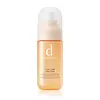What's inside
What's inside
 Key Ingredients
Key Ingredients

 Benefits
Benefits

 Ingredients Side-by-side
Ingredients Side-by-side

Water
Skin ConditioningDipropylene Glycol
HumectantButylene Glycol
HumectantGlycerin
HumectantCyclopentasiloxane
EmollientTranexamic Acid
AstringentErythritol
HumectantPEG/PPG-17/4 Dimethyl Ether
Skin ConditioningDipotassium Glycyrrhizate
HumectantAllantoin
Skin ConditioningXanthan Gum
EmulsifyingPhytosteryl/Octyldodecyl Lauroyl Glutamate
Skin ConditioningPEG/PPG-14/7 Dimethyl Ether
Skin ConditioningLamium Album Flower/Leaf/Stem Extract
Skin ConditioningPhellodendron Amurense Bark Extract
Skin ConditioningDimethicone
EmollientCarbomer
Emulsion StabilisingAcrylates/C10-30 Alkyl Acrylate Crosspolymer
Emulsion StabilisingSodium Metabisulfite
AntioxidantTocopherol
AntioxidantPhenoxyethanol
PreservativeWater, Dipropylene Glycol, Butylene Glycol, Glycerin, Cyclopentasiloxane, Tranexamic Acid, Erythritol, PEG/PPG-17/4 Dimethyl Ether, Dipotassium Glycyrrhizate, Allantoin, Xanthan Gum, Phytosteryl/Octyldodecyl Lauroyl Glutamate, PEG/PPG-14/7 Dimethyl Ether, Lamium Album Flower/Leaf/Stem Extract, Phellodendron Amurense Bark Extract, Dimethicone, Carbomer, Acrylates/C10-30 Alkyl Acrylate Crosspolymer, Sodium Metabisulfite, Tocopherol, Phenoxyethanol
Tranexamic Acid
AstringentDipotassium Glycyrrhizate
HumectantYeast Extract
Skin ConditioningTrehalose
HumectantXylitol
HumectantErythritol
HumectantSalvia Officinalis Extract
AntimicrobialThymus Extract
Skin ConditioningPinus Pinaster Leaf Extract
Skin ConditioningGlycerin
HumectantWater
Skin ConditioningButylene Glycol
HumectantPropanediol
SolventDipropylene Glycol
HumectantPolyglyceryl-3 Decyltetradecyl Ether
EmulsifyingSodium Citrate
BufferingSodium Metaphosphate
BufferingCitric Acid
BufferingSodium Metabisulfite
AntioxidantEthylene/Propylene Copolymer
AbrasiveRhododendron Weyrichii Extract
Skin ConditioningPhenoxyethanol
PreservativeTranexamic Acid, Dipotassium Glycyrrhizate, Yeast Extract, Trehalose, Xylitol, Erythritol, Salvia Officinalis Extract, Thymus Extract, Pinus Pinaster Leaf Extract, Glycerin, Water, Butylene Glycol, Propanediol, Dipropylene Glycol, Polyglyceryl-3 Decyltetradecyl Ether, Sodium Citrate, Sodium Metaphosphate, Citric Acid, Sodium Metabisulfite, Ethylene/Propylene Copolymer, Rhododendron Weyrichii Extract, Phenoxyethanol
 Reviews
Reviews

Ingredients Explained
These ingredients are found in both products.
Ingredients higher up in an ingredient list are typically present in a larger amount.
Butylene Glycol (or BG) is used within cosmetic products for a few different reasons:
Overall, Butylene Glycol is a safe and well-rounded ingredient that works well with other ingredients.
Though this ingredient works well with most skin types, some people with sensitive skin may experience a reaction such as allergic rashes, closed comedones, or itchiness.
Learn more about Butylene GlycolDipotassium Glycyrrhizate comes from licorice root.
Extracts of licorice have demonstrated to have antibacterial, anti‐inflammatory, antiviral, antioxidant properties.
One component, glabridin, has extra potent antioxidant and soothing properties. It has also been found to block pigmentation from UVB rays in guinea pigs.
Licorice Root also contains a flavonoid. Flavonoids are a natural substance from in plants. Flavonoids also have antioxidant properties.
Another component, glycyrrhizin, has been found to have anti-inflammatory and antimicrobial benefits. This may make licorice root extract effective at treating acne. However, more research is needed to support this.
Liquiritin is one of the flavone compounds found in licorice. It has been found to help lighten skin by preventing tyrosinase from reacting with tyrosine. When the two react, protein is converted to melanin. Melanin is the substance in your body that gives your features pigmentation.
Licorice root is native to Southern Europe and Asia. It has been used in traditional Chinese medicine to help with respiratory issues.
Learn more about Dipotassium GlycyrrhizateDipropylene Glycol is a synthetically created humectant, stabilizer, and solvent.
This ingredient helps:
Dipropylene glycol is technically an alcohol, but it belongs to the glycol family (often considered part of the ‘good’ alcohols). This means it is hydrating and gentle on skin unlike drying solvent alcohols like denatured alcohol.
As a masking agent, Dipropylene Glycol can be used to cover the smell of other ingredients. However, it does not have a scent.
Studies show Dipropylene Glycol is considered safe to use in skincare.
Learn more about Dipropylene GlycolYou might know this ingredient as a sugar substitute in foods. It is a sugar alcohol with humectant properties.
Humectants attract water to your skin (like glycerin or hyaluronic acid).
Fun fact: Erythritol can be naturally found in some fermented foods.
Learn more about ErythritolGlycerin is already naturally found in your skin. It helps moisturize and protect your skin.
A study from 2016 found glycerin to be more effective as a humectant than AHAs and hyaluronic acid.
As a humectant, it helps the skin stay hydrated by pulling moisture to your skin. The low molecular weight of glycerin allows it to pull moisture into the deeper layers of your skin.
Hydrated skin improves your skin barrier; Your skin barrier helps protect against irritants and bacteria.
Glycerin has also been found to have antimicrobial and antiviral properties. Due to these properties, glycerin is often used in wound and burn treatments.
In cosmetics, glycerin is usually derived from plants such as soybean or palm. However, it can also be sourced from animals, such as tallow or animal fat.
This ingredient is organic, colorless, odorless, and non-toxic.
Glycerin is the name for this ingredient in American English. British English uses Glycerol/Glycerine.
Learn more about GlycerinPhenoxyethanol is a preservative that has germicide, antimicrobial, and aromatic properties. Studies show that phenoxyethanol can prevent microbial growth. By itself, it has a scent that is similar to that of a rose.
It's often used in formulations along with Caprylyl Glycol to preserve the shelf life of products.
Sodium metabisulfite is also known as Sodium Pyrosulfite. It is a preservative, antioxidant, and disinfectant.
As a preservative, it helps stabilize cosmetic formulas without affecting their color or scent.
Tranexamic Acid is best used for treating hyperpigmentation, discoloration, and melasma. It can also help build a stronger skin barrier.
Once applied, Tranexamic Acid starts decreasing inflammation from UV exposure. Tranexamic Acid also prevents our skin cells from meeting the pigment production cells.
Its brightening property makes it great at reducing the appearance of acne scars and marks.
Fun fact: Tranexamic Acid is also a medication used to reduce heavy bleeding.
This acid is derived from lysine, an amino acid.
Learn more about Tranexamic AcidWater. It's the most common cosmetic ingredient of all. You'll usually see it at the top of ingredient lists, meaning that it makes up the largest part of the product.
So why is it so popular? Water most often acts as a solvent - this means that it helps dissolve other ingredients into the formulation.
You'll also recognize water as that liquid we all need to stay alive. If you see this, drink a glass of water. Stay hydrated!
Learn more about Water